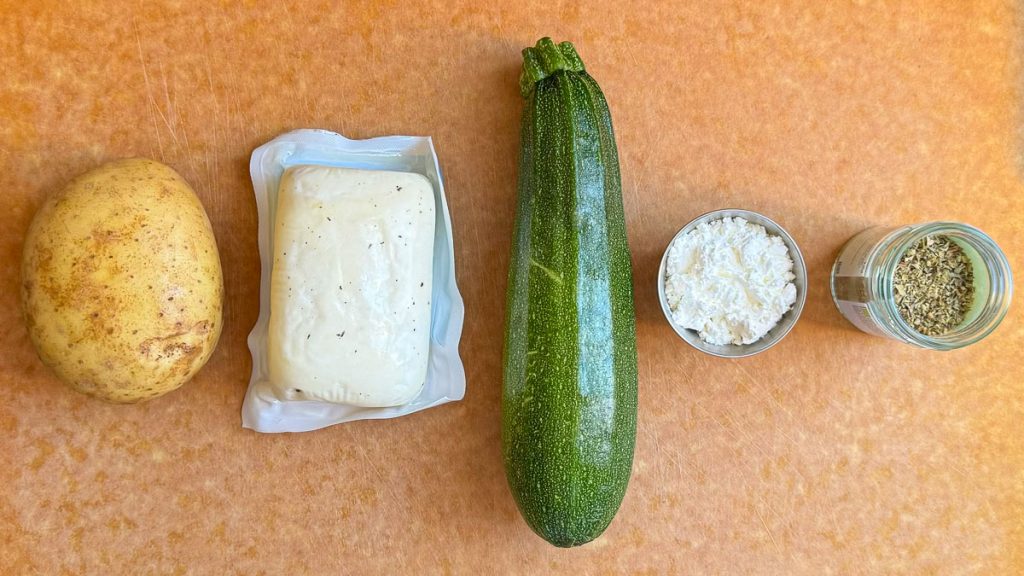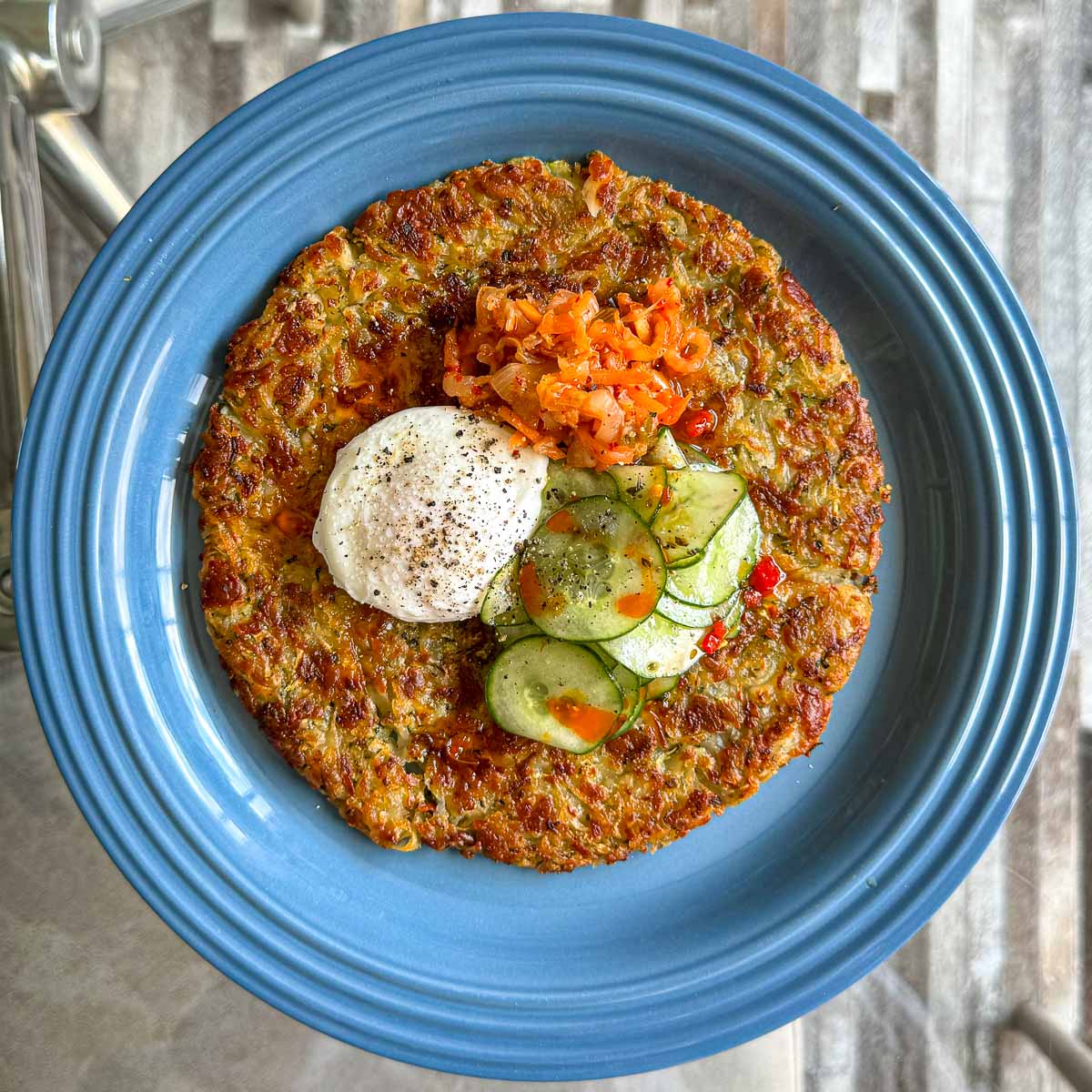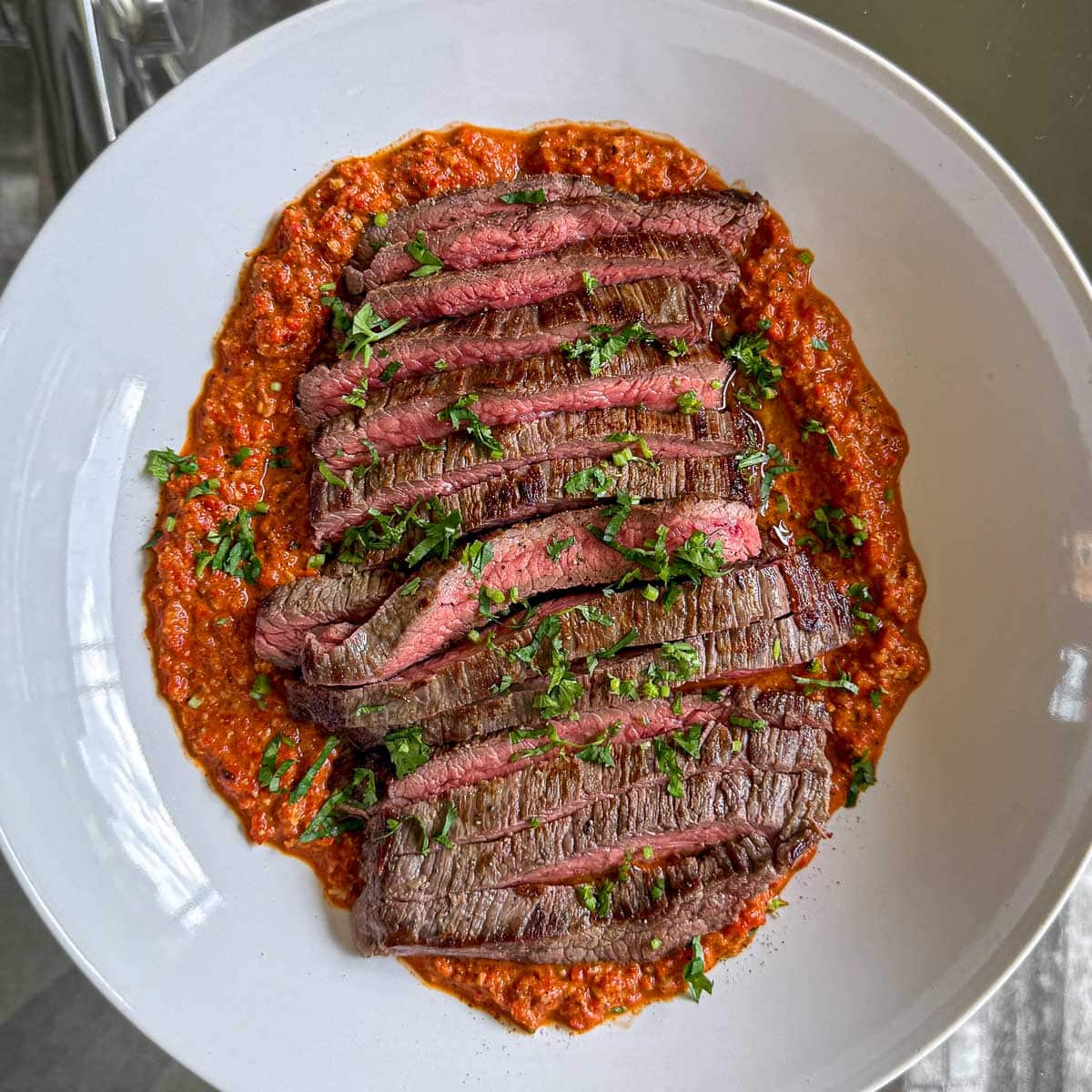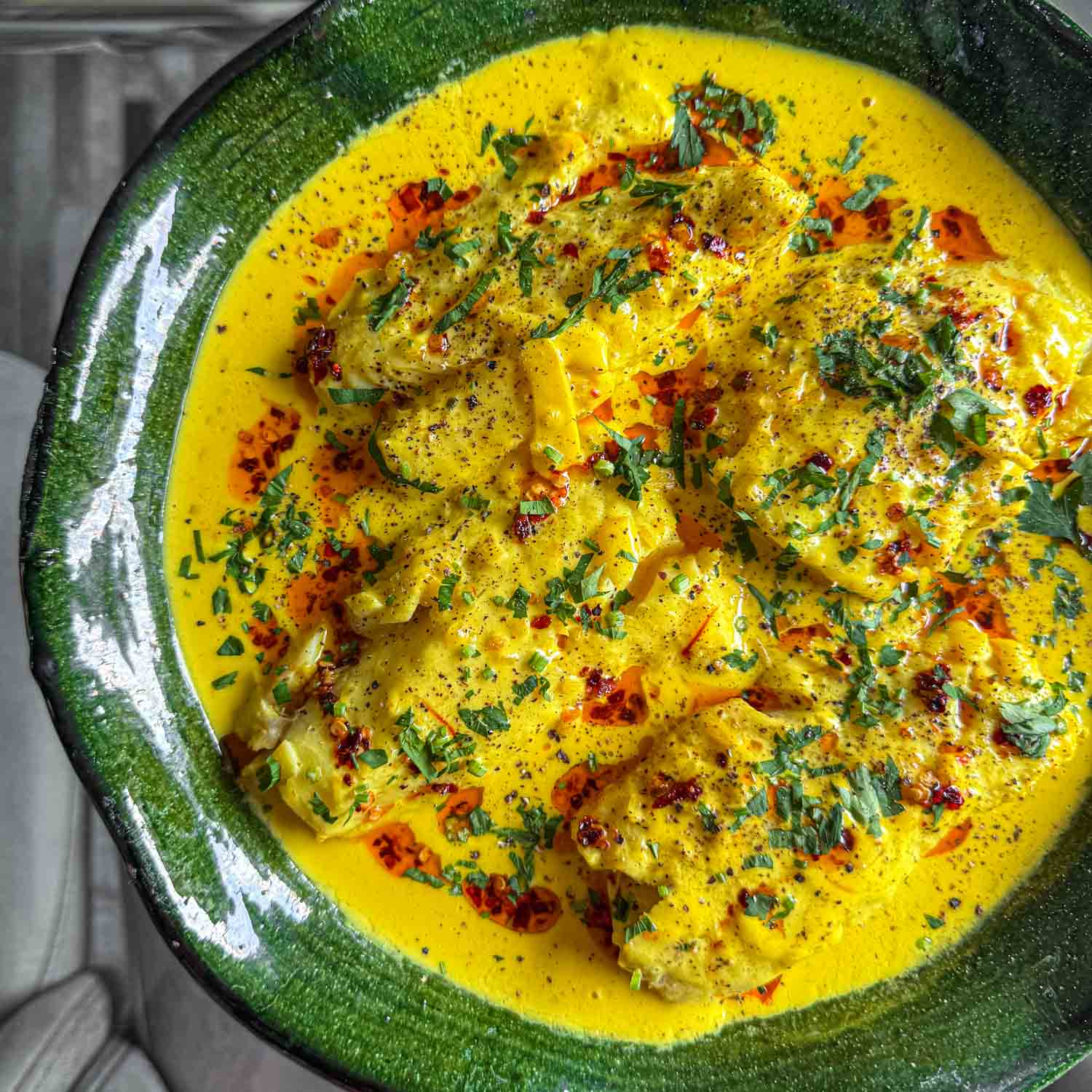A golden, crispy rosti is a beautiful thing but a courgette and halloumi rosti is even better!
Rosti is a Swiss-inspired dish traditionally made from grated potatoes and cooked until golden brown and crispy. This version brings a fresh, Mediterranean twist by adding courgette and halloumi, creating a unique combination of textures and flavours. It’s a versatile recipe that works as a satisfying breakfast, a light lunch, or even a side dish for dinner.
But what makes this dish truly shine? The balance between the crispiness of the rosti and the soft interior, with the salty bite of halloumi, creates something truly memorable. Let’s dive into the details of this mouth-watering dish.
Table of Contents
- Ingredient Breakdown
- Picking the Right Potato for this Courgette and Halloumi Rosti
- The Key to a Crispy Rosti
- What Halloumi Brings to the Table
- You Need a Good Non-Stick Pan to Make This Courgette and Halloumi Rosti
- Why You Should Try This Courgette and Halloumi Rosti

Ingredient Breakdown
- Potatoes: The base of the rosti. Their natural starch helps bind the mixture and gives it that crisp texture. Leave the skins on for extra flavour and nutrients.
- Courgette: Adds freshness and lightness, though it requires extra care to remove as much moisture as possible. It brings a subtle flavour while helping balance the saltiness of the halloumi.
- Halloumi: Salty, squeaky, and utterly delicious when paired with the earthy potatoes and courgette. It adds a savoury depth to the dish.
- Cornstarch (Cornflour): Acts as a binding agent, helping to hold the rosti together as it crisps up in the pan.
- Dried Oregano: A Mediterranean herb that adds a bit of earthiness, complementing the flavours of the halloumi.
- Vegetable Oil: Ensures the rosti gets its golden brown, crispy crust. You can reduce the oil if using a high-quality non-stick pan.
Picking the Right Potato for this Courgette and Halloumi Rosti
When it comes to making a rosti, the type of potato you choose can have a significant impact on the texture and flavour of your final dish. While there’s no hard and fast rule, it’s worth understanding the difference between waxy and floury potatoes to help you decide what suits your preferences best.

Waxy Potatoes: Crisp and Defined, Perfect for Rosti
Waxy potatoes, such as Charlotte or Jersey Royals, are famous for holding their shape well when cooked. This makes them an excellent choice for rosti if you want defined strands of potato that keep their integrity as they cook.
- Texture: The firm structure of waxy potatoes means they don’t break down as easily. This gives your rosti a more solid, crunchy exterior while maintaining a soft, but not overly fluffy, interior.
- Crispiness: Waxy potatoes tend to get slightly crispier than their floury counterparts. This is perfect if you’re aiming for a more pronounced crunch on the outside. The individual potato strands stay intact, resulting in a rosti that’s visually appealing and has a bit more bite.
Floury Potatoes: Soft and Fluffy
Floury potatoes, like Maris Piper or King Edward, break down more when cooked. This makes them ideal for creating a softer, fluffier texture inside your rosti. This gives the dish a slightly different character, closer to a mashed potato cake in some ways.
- Texture: The starch in floury potatoes releases easily, which leads to a more tender, light interior. If you enjoy a contrast between a crispy outside and a mashed-like softness on the inside, floury potatoes are a great option.
- Crispiness: While floury potatoes also crisp up nicely, the texture will be less defined than with waxy varieties. You’ll get a golden crust, but the interior will have a more uniform texture, making it a softer bite overall.
Ultimately, the potato you choose depends on your texture preference. Waxy potatoes will give you a crunchier, more defined rosti, while floury potatoes will bring that light, fluffy interior. Whichever you choose, as long as you nail the crispy exterior, your rosti will be a delicious success.
The Key to a Crispy Rosti
One of the keys to a perfect rosti is removing as much moisture as possible from the potatoes and courgettes before cooking. Moisture is the enemy of crispiness. While it’s easy to focus on the courgette’s high water content, don’t forget that even potatoes hold onto moisture.
The best way to drain both is to use a clean tea towel. After grating, pile everything into the middle of the towel, twist the ends, and wring it out like you mean it. The amount of liquid that comes out will shock you! And don’t rush this step; taking the time to remove all excess moisture makes all the difference when aiming for that golden, crispy exterior.

What Halloumi Brings to the Table
Halloumi had a high melting point, which makes it a fantastic addition to dishes that require cooking at high heat, like rosti. But what really sets halloumi apart in this Courgette and Halloumi Rosti recipe is its texture. Unlike other cheeses that melt and ooze, halloumi holds its structure, giving you a bit of chewiness with every bite.
Its saltiness also eliminates the need for additional seasoning in the rosti mixture. It brings depth and umami, cutting through the mildness of the potato and courgette, while also adding to the crispy factor when cooked.
You Need a Good Non-Stick Pan to Make This Courgette and Halloumi Rosti
When it comes to making the perfect rosti, a quality non-stick pan can make all the difference. A good non-stick surface allows you to use less oil while still achieving that beautifully golden, crispy crust. In fact, if your pan is truly non-stick, you can reduce the oil by a third without compromising the texture. This makes for a lighter dish, letting the flavours of the halloumi and courgette stand out without being overwhelmed by too much fat.
Why is non-stick so crucial? Because a sticky pan can be disastrous for rosti. You risk tearing the delicate potato mixture when flipping, leaving you with a patchy, uneven crust that detracts from the experience. Investing in a reliable non-stick pan ensures a smooth cooking process, and your rosti will turn out perfectly crisp and intact every time.
For this Courgette and Halloumi Rosti, I used my trusted Le Creuset 24cm Toughened Non-Stick Frying Pan. In full transparency, this pan was gifted as part of a paid social media campaign. However, I can honestly say that it’s the best non-stick pan I’ve come across, and it has a lifetime guarantee—which means it’s a long-term ally in the kitchen.
Why You Should Try This Courgette and Halloumi Rosti
This Courgette and Halloumi Rosti is more than just a dish—it’s a celebration of simple ingredients coming together to create something greater than the sum of their parts. The contrast between the crispy edges, the tender interior, and the chewy halloumi makes every bite satisfying.
It’s also a flexible dish that can be adapted to suit your personal taste. Fancy adding some herbs to the mix? Go for it. Want to experiment with different toppings? The sky’s the limit. And if you’re looking for a way to use up extra courgettes from the garden, this recipe is the perfect solution.
Whether you’re serving it as part of a weekend brunch or a light weekday meal, this rosti is guaranteed to become a staple in your kitchen. So, grab your grater and get started—you’re in for a treat! And if you fancy trying your hand at another rosti, try my Korean-inspired Kimchi Potato Rosti.
Courgette and Halloumi Rosti (Zucchini)
5 Stars 4 Stars 3 Stars 2 Stars 1 Star
No reviews
Rosti is a Swiss-inspired dish traditionally made from grated potatoes and cooked until golden brown and crispy. This version brings a fresh, Mediterranean twist by adding courgette and halloumi, creating a unique combination of textures and flavours. It’s a versatile recipe that works as a satisfying breakfast, a light lunch, or even a side dish for dinner.
- Author: zenak
- Prep Time: 5 minutes
- Total Time: 30 minutes
- Yield: 2 hungry people 1x
Ingredients
- 200g potatoes, scrubbed (no need to peel, the skin adds flavour and nutrients)
- 125g courgette
- 100g halloumi, grated
- ½ tbsp cornstarch (aka cornflour)
- ½ tsp dried oregano
- 1 tbsp vegetable oil (see Notes for using less oil)
Instructions
- Coarsely grate the potatoes and courgettes straight onto a clean tea towel, then gather up the edges and twist to wring out as much water as possible. Don’t rush this step. Courgettes are very water-dense, so in order to end up with a crispy rosti, you must extract as much moisture from it as you can (moisture is the enemy of crispiness!).
- Transfer the drained potatoes and courgettes to a large bowl. Add the halloumi, cornstarch and dried oregano, then toss until well-combined. No need for salt here as halloumi is naturally very salty.
- Heat half of the oil in a 24cm (or thereabouts) non-stick frying pan set over a medium-low heat, then add the rosti mixture.
- Using a heatproof rubber spatula, spread the mixture out into an even layer, gently pressing down to ensure it makes good contact with the pan and tucking the edges in to create a neat disk.
- Cook, gently pressing down on the rosti and running a spatula around the edges and bottom to prevent sticking, for 12 minutes, or until the bottom is golden brown and crispy. If it’s not starting to brown by the 8 minute mark, increase the heat to medium.
- Just before you flip the rosti, run the spatula around the edges and give the pan a shake until you feel the rosti freely move around the pan. Place a plate or chopping board over the pan and flip.
- Heat the other half of the oil in the pan, then carefully slide the rosti back into the pan, uncooked-side-down. Tuck the edges in to create a neat disk and cook for 12 minutes, or until golden brown and crispy on the bottom. Again, if it’s not starting to brown by the 8 minute mark, increase the heat to medium.
- You can use this time to prepare your toppings. I went with poached egg, marinated cucumber, kimchi and honey, but you could use anything you’d like: smoked salmon, avocado, seared mushrooms, sautéed spinach – the possibilities are endless.
Notes
- If you have a very good non-stick frying pan, you can reduce the butter amount by ⅓ (i.e. 1 tsp instead of 1 tbsp).
- If scaling up the recipe, you’ll need to fry the rosti in batches.









